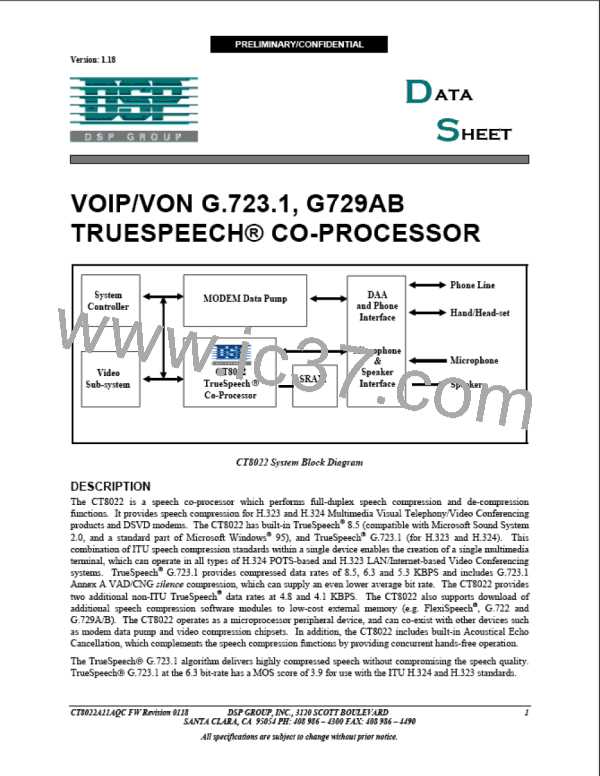Version: 1.18
PRELIMINARY/CONFIDENTIAL
TrueSpeech® Co-Processor
A.8
Control Algorithm Example
We provide this example for illustrative purposes only; system designers are free to construct their own control
algorithms as desired.
On detection of an incoming call (off-hook preceded by ringing signal), the Host controller should start the
speakerphone in half-duplex mode. The Host should then wait around 200ms following the off-hook transition
before sending the electrical echo canceller training pulse to allow the line conditions to stabilize. After the training
pulse has been sent, the Host should query the CT8022 to determine if electrical echo canceller training was
successful. If not, the Host should attempt re-training at 500ms intervals for a total of three attempts. If training is not
successful after three attempts, the Host should continue to let the speakerphone operate in half-duplex mode.
Training will only fail if there is excessive noise present on the telephone line at the instant that the CT8022 attempts
to send the training pulse. As an option, the system designer can provide a manual training or reset button, so that the
user can decide when to send the training pulse.
On an outgoing call (e.g. speed dial), the Host again starts the speakerphone in half-duplex mode. After dialing of the
second digit, the Host should wait 50ms and then attempt to send the training pulse. Once the training pulse has been
sent, the Host can check whether the training process succeeded, or not. If training fails, the Host can try to train the
electrical echo canceller after the third and subsequent digits, until adequate training is achieved. In the event that
training is not possible, the Host can allow the speakerphone to continue operation in half-duplex mode. Sending the
training pulse after the second digit is recommended, since in many installations a secondary dial tone may be
presented after dialing of the first digit (for example dialing 9 for an external (public network) line).
Training needs to be achieved successfully only once during a call, as long as the physical line conditions do not
change. An example of a change that would require re-training is the situation where a second telephone goes off-
hook and operates in parallel with the original telephone.
Note that true full duplex operation will only be achieved after the electrical echo canceller has successfully trained
and the acoustic echo canceller has had time to self-adjust. The acoustic echo canceller is only updated when the
telephone line side is talking and the microphone side is silent. This may require a few seconds. When operated in
loop adjustment mode 10 (the recommended setting), the CT8022 compensates for the initial start-up conditions by
inserting additional loop attenuation. Once the acoustic echo canceller has stabilized, the additional loop attenuation
is reduced and then removed.
Note that in an implementation where the microphone and speaker are physically separate from each other (this is the
preferred implementation), the user should be discouraged from moving either microphone or speaker during a call.
When the microphone and speaker change relative positions, the acoustic echo canceller has to work harder to
compensate for the changed acoustic echo path. Under these circumstances, in loop adjustment mode 10, the
CT8022 may again introduce temporary extra loop attenuation until the situation re-stabilizes. In addition, if the user
desires to change the loud speaker volume, this should be done via the CT8022 controls and not by changing the
external speaker amplification.
CT8022A11AQC FW Revision 0118 DSP GROUP, INC., 3120 SCOTT BOULEVARD
SANTA CLARA, CA 95054 PH: 408 986 – 4300 FAX: 408 986 – 4490
183
All specifications are subject to change without prior notice.

 ETC [ ETC ]
ETC [ ETC ]